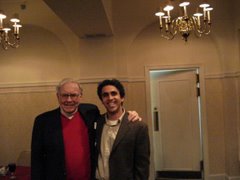So naturally, I enjoy reading the company’s annual letter to shareholders for any nuggets of wisdom or investment ideas since Leucadia is nothing more than a conglomerate of investment holdings. Reading Leucadia's annual letter over the weekend, I was intrigued by Cummings and Steinberg's assessment of the future.
"Out of prudence we have a pessimistic view as to when this recession will end. To think otherwise would be to gamble about the beginnings of good times whereas by imagining a bleak future we will most likely survive for the good times to arrive."
I find the above statement to be one of the greatest pieces of investment wisdom I've come across recently. Investors would be well served to take the above assessment and apply it to their investments going forward. I like to call it an “invest for the worst and hope for the best” kind of approach to investing today.
My approach stems from the fact that investors are crazy if they are analyzing most businesses based on 2007 profits/multiples. Don't get me wrong: we could very well be easily sitting in the midst of the greatest buying opportunities of a lifetime. Indeed, I lean towards this view. However, it's with prudence that investors must assume that the market will remain in a funk in order to profit handsomely when spring does come. Because if you assume the worst, your investment process, by default, will become much more skeptical. All investors should arm themselves with a healthy does of skepticism at all times.
The wonderful thing about 45% market declines is that many stocks fall a lot a harder, thus setting the setting for phenomenal returns. Forget the preverbial 50 cent dollar - they are a dime a dozen today. Thirty cent - even ten cent dollars - can be found today with a little extra effort.
True value investors are not afraid to pounce if a security is widely undervalued. They time stock prices and not stock markets. In a recent interview Buffett said he would relish the opportunity to be in his 20's all over again today.
We're certainly not out of the woods yet, and it seems that it really won't be until 2011 until the economy recovers again. But it's a guessing game as to when the stock market will turn - they are forward looking creatures after all. But then again, value investors aren't timing stock markets.


5 comments:
I enjoy your posts. Too few and too far between. What's your book about?
Thanks for the kind words.
The book deals with the common sensical way to pursue value investing. The information contained in it is not original - that was given to us by Graham via Buffett - but I think it's presentation is.
good post ... i like the quote. in a market like this, where there are opportunities everywhere, the quote brings you back to the fundamentals of value investing.
Good to see that you posting your thoughts again.
Great post! I also believe you can find great value in today's market if one is willing to do their homework. Agreed, relying on 2007 multiples is sure to yield meager results. Personally, I rely on a DCF model in all my valuations. I've managed to find a nice eighty cent to the dollar stock which you can find out about on my blog: terminalvalue.blogspot.com. I'd like to hear your comments! When is your book available?
Post a Comment